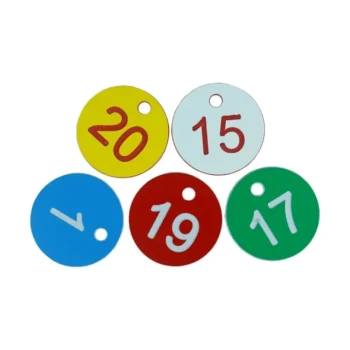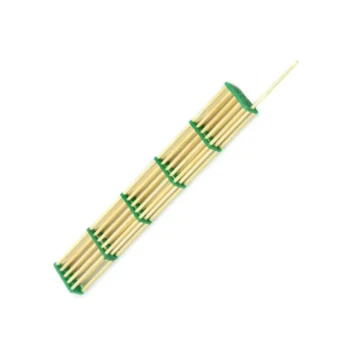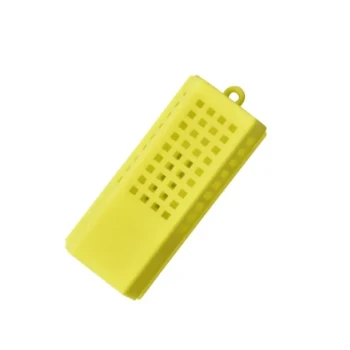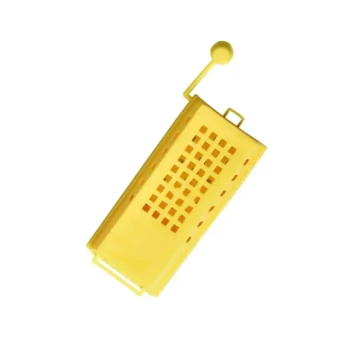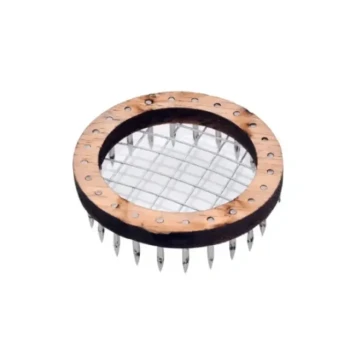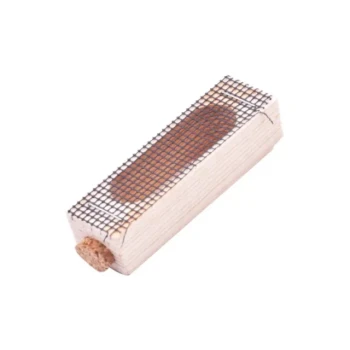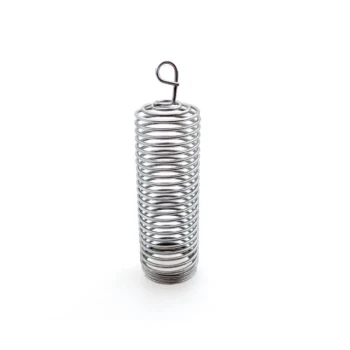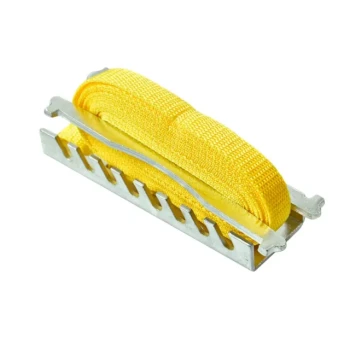At its core, the color coding system for queen bees is a simple, international standard used by beekeepers to know the year a queen was hatched. A specific color is assigned to the last digit of the year, allowing a beekeeper to identify the queen's age at a single glance. The five-year repeating pattern uses white, yellow, red, green, and blue.
The queen's color is more than just an ID tag; it is a critical data point for hive management. It allows you to instantly assess the age, and therefore the likely productivity and vigor, of your colony's single most important member.

Why Marking Your Queen is a Foundational Skill
While you can manage a hive without a marked queen, doing so is like flying blind. A small dot of paint provides immediate and valuable information that simplifies nearly every aspect of beekeeping.
Instantly Confirm Her Presence
A queenless colony is in a state of emergency and will eventually perish. Finding the queen among 50,000 other bees can be a slow, stressful task. A quick scan for a spot of color instantly confirms she is present and working, turning a 10-minute search into a 10-second glance.
Assess Queen Age and Vigor
A queen's egg-laying ability peaks in her first or second year and declines thereafter. A colony with an aging queen will see its population shrink, reducing honey production and making it more vulnerable. Knowing her age allows you to anticipate this decline and plan to replace her proactively.
Track Requeening and Swarms
If you inspect a hive and find an unmarked queen where a marked one used to be, you know a critical event has occurred. The colony has either swarmed (your old queen left) or superseded her (raised a new queen on their own). This knowledge is vital for understanding your colony's current state.
The International Color Code System Explained
The system is elegant in its simplicity. It uses five colors on a five-year rotation, with each color corresponding to years ending in one of two digits.
The Five-Year Cycle
The sequence of colors is always the same: White, Yellow, Red, Green, Blue.
A Mnemonic to Remember
A common and effective way to memorize the order is with the phrase: Will You Raise Good Bees.
The Year-End Digit Rule
This is the key to the entire system. You match the color to the last digit of the year the queen was hatched or introduced to the hive.
- Years ending in 1 or 6: White
- Years ending in 2 or 7: Yellow
- Years ending in 3 or 8: Red
- Years ending in 4 or 9: Green
- Years ending in 0 or 5: Blue
For example, a queen hatched in 2023 would be marked with a red dot. A queen hatched in 2024 would be marked green.
Understanding the Practical Realities
While invaluable, the system isn't without its practical considerations. Acknowledging them makes you a more effective beekeeper.
The Small Risk of Marking
Marking a queen requires catching and gently holding her. While generally safe, there is always a very small risk of damaging her. Using a dedicated queen-marking tube or clip minimizes this risk significantly.
When the Mark Fades
Over time, paint can wear off or be chewed off by worker bees. It's a good practice to check the mark during inspections and reapply it if it's fading, though this is often not necessary.
Unmarked Queens from Suppliers
Not all queen breeders mark their queens. If you buy an unmarked queen, you should mark her yourself with the correct color for the current year before introducing her to the hive.
Making the Right Choice for Your Goal
Applying this knowledge depends entirely on your objectives as a beekeeper.
- If your primary focus is maximizing honey production: Use the color code to requeen proactively after year two, ensuring the colony always has a queen in her peak egg-laying years.
- If your primary focus is hive health and survival: The color mark is your fastest way to confirm your hive is queenright during inspections, allowing you to intervene quickly if she is missing.
- If your primary focus is colony growth and making splits: A young, marked queen is the engine of a strong colony, giving you confidence that a hive is robust enough to be split into a new colony.
Ultimately, this simple color system transforms the queen from an anonymous insect into a known asset whose performance can be tracked over time.
Summary Table:
| Year Ends In | Color | Mnemonic |
|---|---|---|
| 1 or 6 | White | Will |
| 2 or 7 | Yellow | You |
| 3 or 8 | Red | Raise |
| 4 or 9 | Green | Good |
| 0 or 5 | Blue | Bees |
Equip Your Apiary for Success with HONESTBEE
Mastering hive management starts with the right tools. A marked queen is a known asset, and reliable equipment is the foundation of a thriving apiary.
HONESTBEE supplies commercial apiaries and beekeeping equipment distributors with the durable, high-performance supplies needed for efficient large-scale operations. From queen marking kits and hive tools to protective gear and extraction equipment, our wholesale-focused operations ensure you get the quality and value your business depends on.
Ready to strengthen your beekeeping operation? Contact our team today to discuss your equipment needs and wholesale pricing.
Visual Guide
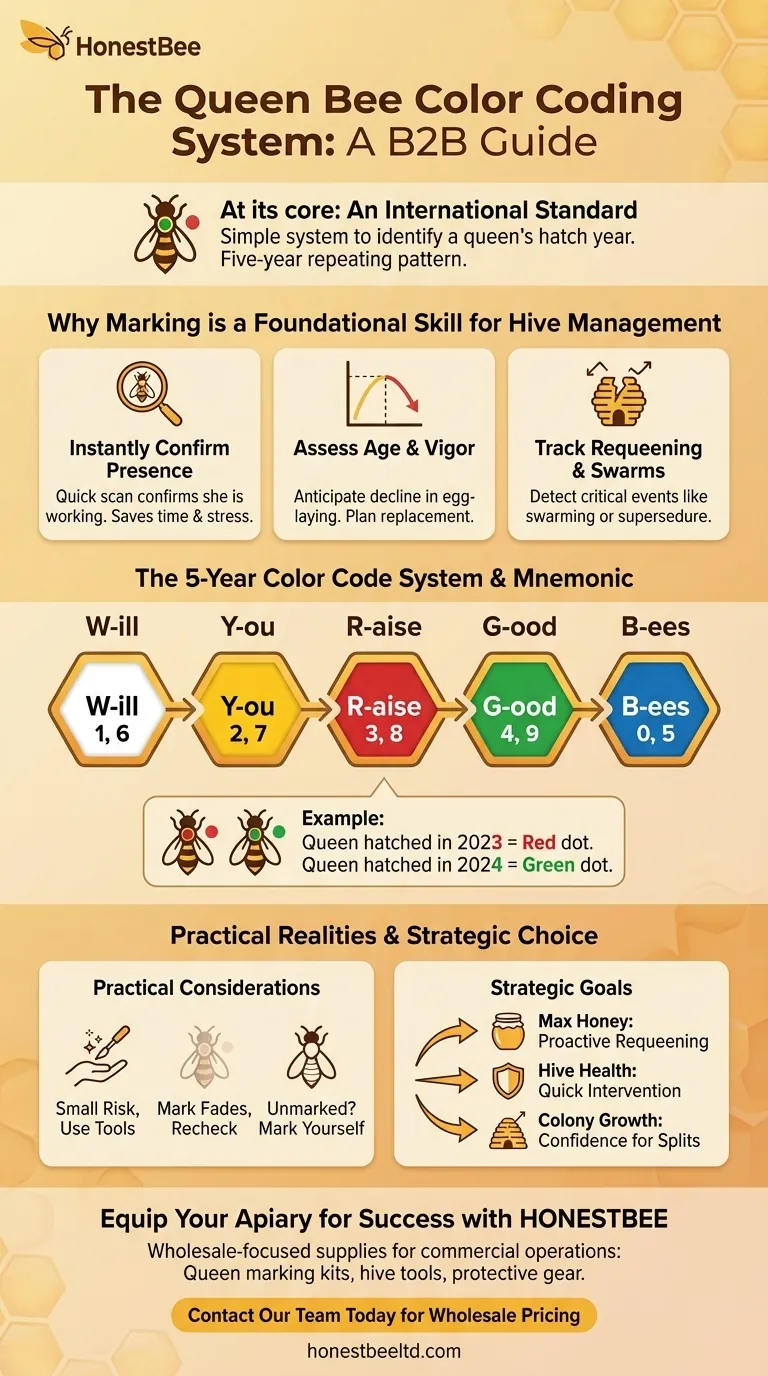
Related Products
- Queen Bee Marking Pen UNI Medium Point for Queen and Bee Marking
- Queen Bee Marking Pen POSCA Queen Marking Pens for Beekeeping Bee Markers
- Queen Bee Marking Tube Cage Bottle Catcher Holder with Clear Plastic Plunger Marker
- Professional Engraved Round Hive Number Tags for Beekeeping
- Professional Bamboo Queen Isolation Cage
People Also Ask
- What is the purpose of a queen marking pen in beekeeping? Essential for Efficient Hive Management
- What is the process for priming a paint pen before marking a Queen bee? Ensure a Safe, Quick Marking Procedure
- What are the characteristics of Posca pens for marking queens? A Safe, Durable Solution for Hive Management
- What are the advantages of using Uni-Posca markers for Queen marking? A Safe, Precise, and Efficient Solution
- How should a Posca pen be prepared for queen marking? Ensure a Safe, Precise Mark Every Time



